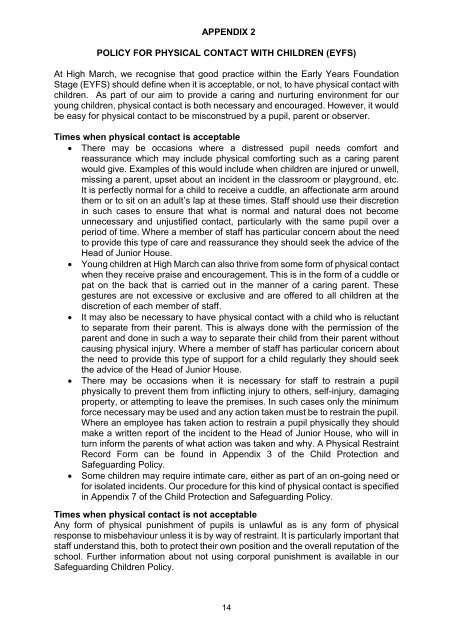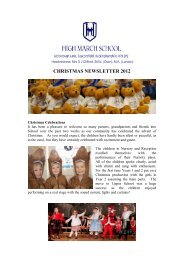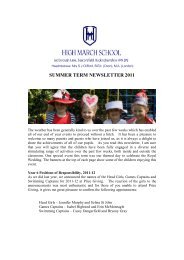Child Protection and Safeguarding Policy - High March School
Child Protection and Safeguarding Policy - High March School
Child Protection and Safeguarding Policy - High March School
You also want an ePaper? Increase the reach of your titles
YUMPU automatically turns print PDFs into web optimized ePapers that Google loves.
APPENDIX 2POLICY FOR PHYSICAL CONTACT WITH CHILDREN (EYFS)At <strong>High</strong> <strong>March</strong>, we recognise that good practice within the Early Years FoundationStage (EYFS) should define when it is acceptable, or not, to have physical contact withchildren. As part of our aim to provide a caring <strong>and</strong> nurturing environment for ouryoung children, physical contact is both necessary <strong>and</strong> encouraged. However, it wouldbe easy for physical contact to be misconstrued by a pupil, parent or observer.Times when physical contact is acceptable There may be occasions where a distressed pupil needs comfort <strong>and</strong>reassurance which may include physical comforting such as a caring parentwould give. Examples of this would include when children are injured or unwell,missing a parent, upset about an incident in the classroom or playground, etc.It is perfectly normal for a child to receive a cuddle, an affectionate arm aroundthem or to sit on an adult’s lap at these times. Staff should use their discretionin such cases to ensure that what is normal <strong>and</strong> natural does not becomeunnecessary <strong>and</strong> unjustified contact, particularly with the same pupil over aperiod of time. Where a member of staff has particular concern about the needto provide this type of care <strong>and</strong> reassurance they should seek the advice of theHead of Junior House. Young children at <strong>High</strong> <strong>March</strong> can also thrive from some form of physical contactwhen they receive praise <strong>and</strong> encouragement. This is in the form of a cuddle orpat on the back that is carried out in the manner of a caring parent. Thesegestures are not excessive or exclusive <strong>and</strong> are offered to all children at thediscretion of each member of staff. It may also be necessary to have physical contact with a child who is reluctantto separate from their parent. This is always done with the permission of theparent <strong>and</strong> done in such a way to separate their child from their parent withoutcausing physical injury. Where a member of staff has particular concern aboutthe need to provide this type of support for a child regularly they should seekthe advice of the Head of Junior House. There may be occasions when it is necessary for staff to restrain a pupilphysically to prevent them from inflicting injury to others, self-injury, damagingproperty, or attempting to leave the premises. In such cases only the minimumforce necessary may be used <strong>and</strong> any action taken must be to restrain the pupil.Where an employee has taken action to restrain a pupil physically they shouldmake a written report of the incident to the Head of Junior House, who will inturn inform the parents of what action was taken <strong>and</strong> why. A Physical RestraintRecord Form can be found in Appendix 3 of the <strong>Child</strong> <strong>Protection</strong> <strong>and</strong><strong>Safeguarding</strong> <strong>Policy</strong>. Some children may require intimate care, either as part of an on-going need orfor isolated incidents. Our procedure for this kind of physical contact is specifiedin Appendix 7 of the <strong>Child</strong> <strong>Protection</strong> <strong>and</strong> <strong>Safeguarding</strong> <strong>Policy</strong>.Times when physical contact is not acceptableAny form of physical punishment of pupils is unlawful as is any form of physicalresponse to misbehaviour unless it is by way of restraint. It is particularly important thatstaff underst<strong>and</strong> this, both to protect their own position <strong>and</strong> the overall reputation of theschool. Further information about not using corporal punishment is available in our<strong>Safeguarding</strong> <strong>Child</strong>ren <strong>Policy</strong>.14





